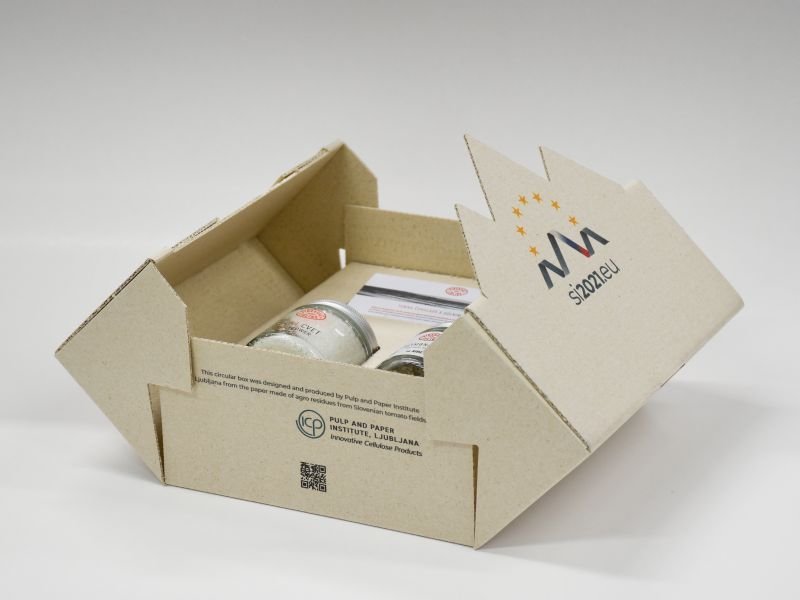The Slovenian Pulp and Paper Institute (ICP) recently presented a corrugated cardboard pack made partly from tomato stems. The tomato stems are from locally sourced agricultural waste that has been processed into liner and fluting papers suitable for incorporation into corrugated board. We spoke to Igor Karlovits, senior researcher at ICP, to find out more about the potential and upscaling prospects and challenges.
Could you tell us a bit more about the process of incorporating the tomato stems into the corrugated board? How does it work?
ICP in Ljubljana is deeply engaged in the research on the cascading use of the residual biomass from wood, agriculture and industry (crops and vegetable production, urban green cuts, i.e invasive plants, forestry, wood and paper production, etc). In our database there are more than 60 different streams evaluated for the potential application.
The initiative for the circular packaging solution by valorisation of the wasted tomato stems started in 2018 in cooperation with the largest tomato producer in Slovenia (trade mark Lušt), based on the idea of replacing of the plastic bags for their products. The chemical and morphological characterization of the tomato stems has proven the quantity and quality of the cellulose fibre being appropriate paper production (over 40% of fibre content, easy to fractionate with traditional kraft delignification processes).
The process of the biomass fractionation, fibre preparation and paper production was simulated and optimized at Institute’s laboratories, following the requirements for the tomato packaging. The material developed has improved strength properties and water/vapour resistance. During paper production and converting bio-based additives such as startch-based glues and bio-based printing colours were used to ensure the material and packaging product are home compostable and in compliance with the regulation for the materials intended for food contact. The scale-up and first production of the paper as well as the design of the paper bag has been provided by Pulp and Paper Institute in 2019 for market tests (25.000 bags). Due to very positive feedback from the market, the tomato stem paper is now being regularly produced on the Institute’s pilot paper machine and the Lušt paper bags have been used in the market for two years.
A logical next step to increase the efficiency in the amount of the producer’s waste valorised, in the process economics, and to enable development of new packaging solutions, was the development of corrugated board. The base paper developed for the bags (a patented process) was further optimized for the production of liners and fluting. The biggest challenge was to find the corrugated board producer with the equipment adjustable for different input materials. A small Slovenian board producer successfully finished the board and the first product – a gift box – was presented for the first time this year.
What percentage of the corrugated board is made from tomato stems?
In order to achieve the appropriate mechanical properties, the paper contains approx. 50% fibers from tomato stems, the remaining are commercially available hardwood and softwood fibres. For all three layers of corrugated board, paper with a grammage of 110 g/m2 was used.
Would it be possible to upscale the process for more widespread use?Expand

As we have successfully tested the process on a pilot (semi-industrial) scale it definitely has a potential for upscaling. However, there are important challenges that have to be addressed – the availability of biomass (or various types of it) in terms of quantity, seasonal availability (storage), dispersed sources (transport), variations in quality etc. The existing wood pulping installations are over capacitated and not necessarily adapted to such intense variations in the incoming raw materials. The majority of the alternative raw materials, in this case tomato plant stems, are diverse, variable and seasonable, therefore the incoming feedstock is not available in quantities for big-scale production in one place which is reflected in high logistic cost.
Upscaling is possible with small to medium scale installations (pulping capacity up to 100 t/day), easily adaptable to various raw materials and connected to upstream (biomass producers, transport and logistic services) as well to downstream value chain (mid-sized paper mills, packaging producers, retailers) and end users (agricultural producers, recycling companies).
An important constraint, recognized in different regions is the lack of the intermediates, RDI institutions that can support the development of new value chains and demonstration of the potential products. Pulp and Paper Institute, with its piloting equipment including biomass fractionation, paper production and a packaging demo centre has developed the paper, corrugated board and packaging products to the level that can be upscaled and replicated.
Have there been any trials with other types of agricultural waste?
Statistics show there is high potential of biomass waste and side streams in Slovenia for biorefining. At the Pulp and Paper Institute we have compiled a database of these raw materials along with their potentially available quantities and most promising fields of use, not only for papermaking but also in for chemicals extraction, enzyme production etc. So far, we have successfully obtained fibres and produced papers from several different sources. Those with most potential, around thirty of them, have been studied in-depth in terms of chemical and morphological structures and the process of cellulose fibre extraction and paper production at lab scale. From agricultural residues and side streams, for instance, we have analysed wheat, straw, hops, barley, corn, among others. The pilot trials and industrial production of paper and paper packaging were developed in cooperation with different partners, i.e., for the local community from the urban green cuts (invasive alien plants, Japanese knotweed, Canadian goldenrod, black locust) or different industries from their waste (i.e. sawdust, wasted jute coffee bags). Some of them are presented under the Institute’s trade mark CiP. All these products are evaluated in terms of their circularity and compliance with the legislative and market requirements. Corrugated cardboard was produced only from paper made from the fibers of tomato plants and Japanese knotweed. However, our knowledge, equipment and the excellent partner network allows us to experiment also with other types of biomasses.
Source:
https://packagingeurope.com/a-closer-look-at-icpc-s-corrugated-cardboard-box-from-tomato-stems/







